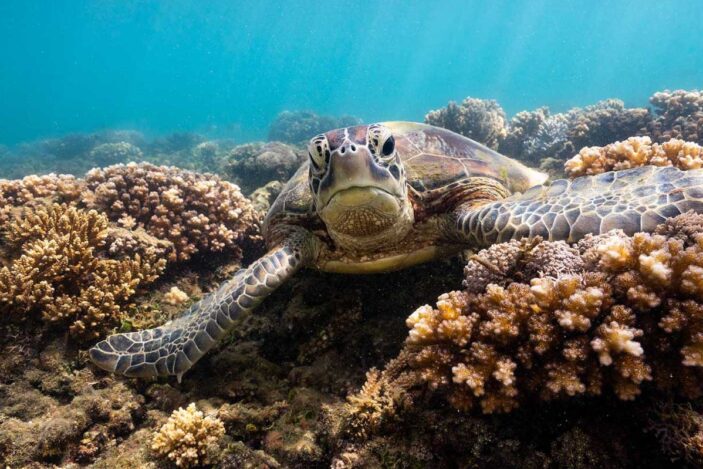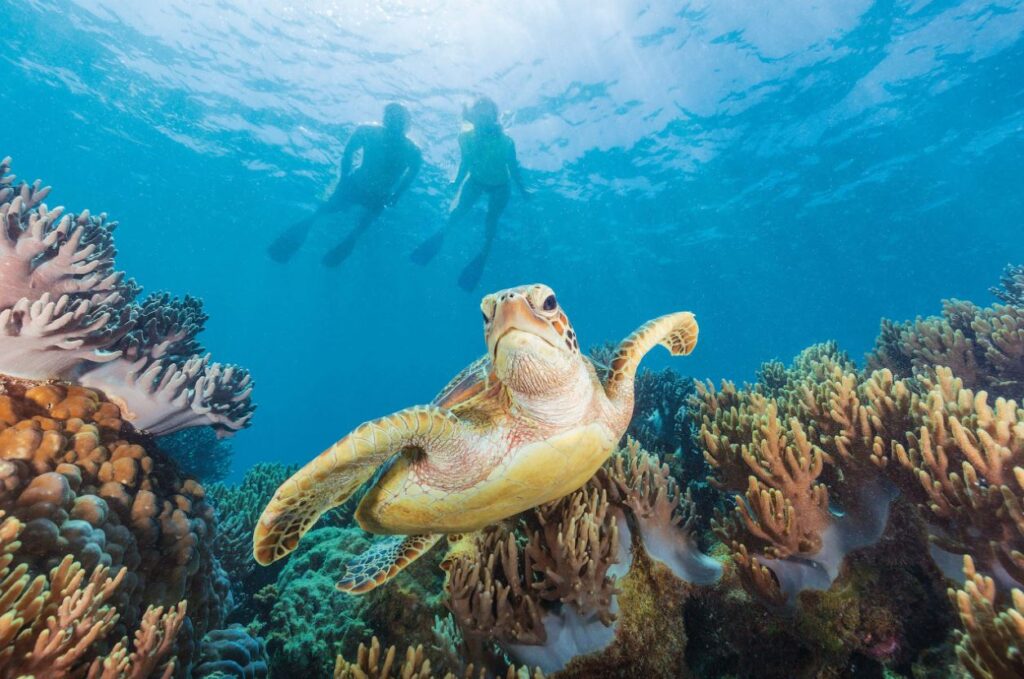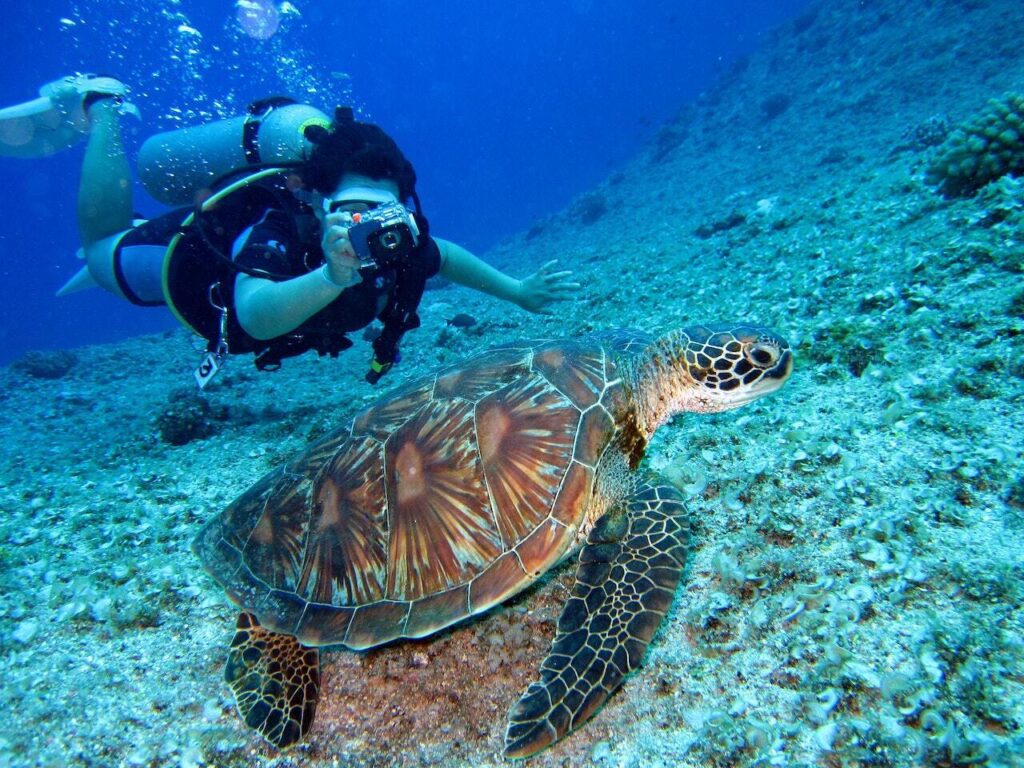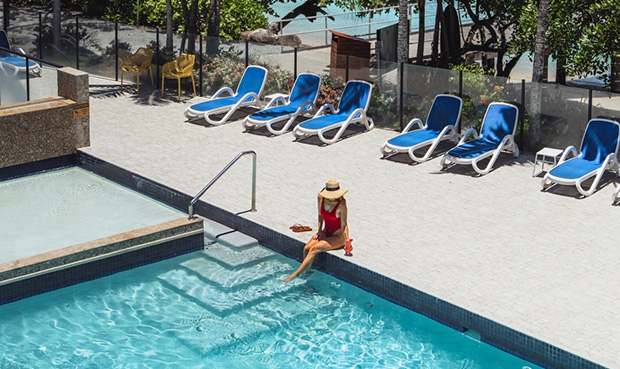The Great Barrier Reef, located off the coast of Australia, stands as the world’s largest coral reef system.
Spanning over 2,300 kilometres, it is made up of 2,900 individual reefs and islands.
This marine ecosystem is not only an international marvel for its biodiversity but also serves as a critical habitat for several species.
Among the reef’s inhabitants, sea turtles hold a special place. As one of the oldest marine species, they have a vital role in maintaining the balance and health of the reef.
In this article, we’ll delve into the significance of turtles in the Great Barrier Reef, where to spot them, and the sanctuaries dedicated to their conservation.
The Importance of Turtles in the Great Barrier Reef
Turtles have long been integral members of the marine ecosystems they inhabit, and the Great Barrier Reef is no exception.
Sea turtles, especially Green sea turtles, feed extensively on seagrass. This grazing not only keeps the seagrass healthy but also ensures that beds are in optimal condition to serve as nurseries for many species of fish and other marine life. Andy, by consuming jellyfish, some turtles help maintain the population balance, ensuring the safety of other marine species.
Sea turtles are considered bioindicators of the health of marine ecosystems. Their well-being can provide insights into the overall health of the ocean environment, making them crucial for marine biologists and conservationists monitoring the reef’s condition.
For thousands of years, the indigenous communities of Australia have held turtles in high regard. They are not only seen as vital food sources but also hold spiritual significance in various indigenous cultures.
Given their ecological and cultural importance, understanding, and protecting turtles is paramount.
Diversity of Sea Turtles in the Great Barrier Reef
The Great Barrier Reef is home to a rich array of marine life, and when it comes to sea turtles, several species have made this reef their habitat. Here’s a closer look at these magnificent creatures:
- Green Turtle (Chelonia mydas): The most commonly sighted turtle in the reef, the Green turtle is named for the greenish hue of its fat, not its shell. Primarily herbivorous, these turtles play a pivotal role in maintaining the health of seagrass beds.
- Loggerhead Turtle (Caretta caretta): Recognisable by their large heads and strong jaws, Loggerheads primarily feed on hard-shelled prey such as crustaceans. They are considered endangered, with the Great Barrier Reef being one of their vital nesting grounds.
- Hawksbill Turtle (Eretmochelys imbricata): Smaller in size and possessing a distinctive hawk-like beak, Hawksbills are known for their beautiful shells which unfortunately make them targets for illegal trade. They mainly feed on sponges, aiding in the reef’s ecosystem balance.
- Flatback Turtle (Natator depressus): Exclusive to the Australian region, these turtles have, as the name suggests, a flat back. They are known to nest only on Australian beaches and are less commonly seen in deep waters.
- Olive Ridley Turtle (Lepidochelys olivacea): Among the smallest of sea turtles, Olive Ridleys have a distinctive olive-colored shell. They’re known for their synchronised nesting in massive numbers, termed “arribadas.”
- Leatherback Turtle (Dermochelys coriacea): The largest of all sea turtles, Leatherbacks can weigh up to 900 kg. Unlike other species, they have a soft, leather-like carapace. Their primary diet consists of jellyfish, and their wide-ranging migratory patterns occasionally bring them to the Great Barrier Reef.
Each of these species has evolved specific behaviours, diets, and habitats, making them unique contributors to the marine ecology of the Great Barrier Reef. Recognising and respecting their roles ensures that the reef remains a vibrant and balanced ecosystem for generations to come.
Turtle Sightings: Where and When to Spot Them
For those interested in witnessing the beauty of sea turtles in their natural habitat, the Great Barrier Reef offers ample opportunities. However, knowing when and where to go can greatly enhance the experience. Here’s a guide to optimise your chances of turtle sightings:
Best Times for Sightings
- Nesting Season: Typically, between November and January, female turtles come ashore to lay their eggs on beaches. This period provides a unique opportunity to witness the nesting process.
- Hatching Season: From January to March, baby turtles, known as hatchlings, make their perilous journey from the sand to the sea, making for a heartwarming spectacle.
Popular Locations
- Heron Island: Renowned for its turtle activity, this island witnesses a significant number of Green and Loggerhead turtles during nesting season.
- Raine Island: As the world’s largest Green turtle rookery, it’s a pivotal nesting ground. However, access is restricted, so sightings are typically from boats or designated viewing areas.
- Fitzroy Island: Home to a turtle rehabilitation centre, the island not only offers wild turtle sightings but also an insight into conservation efforts.
Responsible Turtle Watching
- Maintain Distance: Always give turtles ample space, especially nesting females. Disturbing them can lead to unsuccessful nesting attempts.
- Limit Flash Photography: Bright lights can disorientate hatchlings and adults alike. If photographing, avoid using flash.
- Tread Carefully: When on nesting beaches during the season, be cautious of where you step to avoid harming nests or hatchlings.
Turtle Sanctuaries
Turtles, being vital components of marine ecosystems, face various challenges in the wild. Sanctuaries and rehabilitation centres play a crucial role in ensuring their survival and well-being. In the Great Barrier Reef region, several such facilities are dedicated to turtle conservation. Here’s an overview:
Purpose of Sanctuaries:
- Rehabilitation: Many turtles are found injured due to human activities or natural causes. Sanctuaries provide medical care, helping them recover before releasing them back into the wild.
- Protection: For young turtles, predation is a significant threat. Sanctuaries offer a safe environment for them to grow until they can better fend for themselves.
- Education: These centres also serve as educational hubs, enlightening visitors about turtle conservation and their role in marine ecosystems.
The Fitzroy Island Turtle Rehabilitation Centre is dedicated to the recovery of sick and injured turtles, with an emphasis on educating the public about these marine reptiles and the threats they face.
Supporting Conservation Efforts:
- Adoption Programs: Many sanctuaries offer adoption programs, allowing individuals to support the care and rehabilitation of turtles.
- Volunteering: For those keen on hands-on involvement, volunteering opportunities provide a chance to actively participate in turtle care and conservation activities.
- Educational Visits: By merely visiting and learning from these sanctuaries, individuals can spread awareness and contribute to the broader conservation narrative.
Turtle sanctuaries play an irreplaceable role in the conservation matrix, bridging the gap between humans and these ancient mariners. Their efforts ensure that future generations can continue to marvel at the grace and beauty of turtles in the Great Barrier Reef.
Threats Facing Turtles in the Great Barrier Reef
While the Great Barrier Reef offers a natural habitat for various turtle species, these creatures aren’t without their challenges in these waters. Understanding these threats is essential for informed conservation efforts. Let’s delve into some of the primary concerns:
Human-Induced Threats:
- Fishing Net Entanglement: Turtles often get caught in fishing nets, leading to injuries or, in severe cases, suffocation and death.
- Boat Collisions: Increasing boat traffic in the reef area can lead to accidental collisions, injuring or killing turtles.
- Pollution and Debris: Plastic pollution poses a significant threat. Mistaking plastic for food, turtles can ingest it, leading to digestive blockages or poisoning.
- Illegal Poaching: Despite protective measures, some turtles, particularly Hawksbills with their attractive shells, are targets for illegal poaching and trade.
Natural Threats:
- Predation: Especially for hatchlings, natural predators like birds, crabs, and some fish species can be a threat as they make their first journey to the sea.
- Changing Ocean Temperatures: Rising sea temperatures, a consequence of global warming, can affect the gender balance of turtle hatchlings, as their gender is determined by the temperature of the sand.
- Habitat Degradation: Events like coral bleaching, which affect the health of the reef, indirectly impact the food sources and habitat safety for turtles.
Discover the world of the sea turtle today
The Great Barrier Reef, a marine marvel stretching over vast expanses off the Australian coast, is more than just a testament to nature’s grandeur—it’s a living, breathing ecosystem. At the heart of its intricate web of life are the turtles, age-old mariners that play a pivotal role in maintaining the reef’s ecological balance.
However, as we’ve explored, these creatures face a multitude of challenges, both natural and anthropogenic. The importance of preserving their populations extends beyond mere admiration for their grace and beauty. It’s intrinsically tied to the overall health and vitality of the reef itself.
If you ever find yourself in the Cairns region, come visit the Turtle Rehabilitation Centre here on Fitzroy Island to learn more about the incredible sea turtles of our world.







